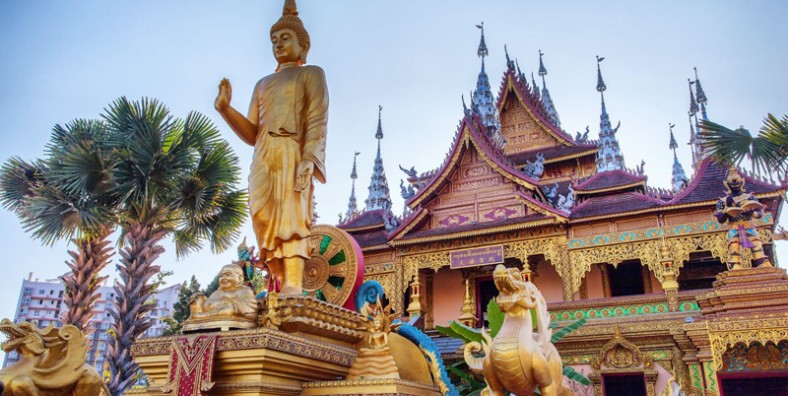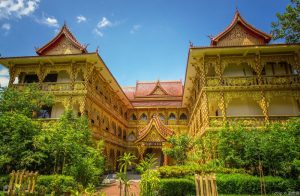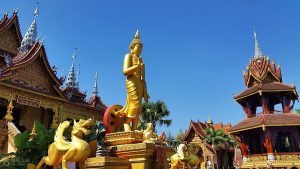Zongfosi Temple in Jinghong City, Xishuangbanna

Chinese Name: 景洪总佛寺
Chinese Pinyin: Jing Hong Zong Fo Si
English Name: Jinghong Zongfosi Temple
Type: historical relics, Hinayana Buddhism
Recommended Visiting Hours: 1 hour
Best Time to Visit: October to April
Location: Jinghong City, Xishuangbanna, Yunan Province
Zongfosi Temple
Jinghong Zongfosi Temple is located in a big courtyard in Jinghong City, near the Manting Park. It is the center for Buddhists to pay reverence to Buddha, also the oldest temple of Xishuangbanna. It consists of the Weihan- Buddha temple, Teaching Building of Buddhist College, Subo Pavilion and monk rooms. It has an area of 3,000 square kilometers.
Why is Zongfosi so special?
Zongfosi is the leading temple of Xishuangbanna, also the oldest one. Before the Reform and Opening, it was the holy land where Zhaopianling, the chieftain of Xishuangbanna, worship Buddha. It goes through the millennium vicissitudes. It is the holy land of Hinayana Buddhism, even renowned in south Asian.
Where is Zongfosi Temple?
It is situated in Jinghong City of Xishuangbanna, Yunnan Province. It also neighbors Manting Park.
How to Get to Zongfosi Temple?
From Xishuangbanna Gasa Airport: take No.1 Bus to Zongfosi Temple, about 50 minutes
From Jinghong Passenger Station: take No.4 Bus to Zongfosi Temple, about 40 minutes
History

Xishuangbanna Zongfosi Temple was built in 615 by two monks from Burma at first, enjoying the history of 1300 years. Zongfosi is the oldest Buddhist Temple of Xishuangbanna, also the leading temple in Xishuangbanna. Before the Reform and Opening, it was the holy land where Zhaopianling, the chieftain of Xishuangbanna, worship Buddha. It goes through the millennium vicissitudes. After five-time reconstruction, it is renewed and becomes the grandest temple in Xishuangbanna.
Legend
According to the local legendary, Buddhism was very popular when it was introduced to Xishuangbanna. Local people pay high reverence to Buddhism. They made the Buddha statues by diverse materials. One day, they found there was no bamboo statue. Though Xishuangbanna boasted bamboos, it was too hard to waving the statue with bamboos. However, they still tried hard. Finally, a skillful craftsman nearly finish, but without the head of Buddha, because it was difficult to show the mercy and kindness of Buddha. There was a old man coming here and telling local people he can do it when they were very disappointed. After a night, the Buddha statue was vivid. Local people believed that it was Buddha who made the wish of Buddhists come true.

Main Attractions
Bodhi Tree
There is a Bodhi tree in the northwest of yard. It was planted by the princess of Thailand, Shilintong. The Bodhi tree is the symbol of friendship between Thailand and China.
Buddha Statues
There are many statues and scriptures in Zongfosi temple. There is one special Buddha statue, with seven dragon-head shaped hands stretching out and embracing his head.
Nearby Attractions
Manting Park, also called Chunhuan Park,(Chinese name: 春欢公园 or 曼听公园) is the oldest garden in Xishuangbanna area, which covers an area of 23,540 square meters. It used to be the imperial garden in ancient times. Its name “Chunhuan” in Dai language means “Soul”. The whole park can be divided into 8 sightseeing areas, they are National Cultural Square, Liana Zone, Tropical Orchid Garden, Peacock Garden, Lake Area and Buddhism Cultural Zone, Tree Planting Zone and Tea Garden. In the day time, people can appreciate the beauty of varied tropical plants and creatures, but at night, a different experience can let the tourists get a closer look of local customs and culture – Minority Dancing Show and Bonfire Party.
Xishuangbanna Primeval Forest Park
Xishuangbanna Primeval Forest Park, also called Xishuangbanna Virgin Forest Park, is 8 kilometers east of the Jinghong City and north of the Lancang River. Situated in a river valley of 720 to 1,355 meters above sea level, the forest park has an area of 1,700 hectares of which 98% is covered by trees, and is thus the largest comprehensive ecological place of interest in the prefecture. The park gives prominence to the features of primeval forest, wild animals and ethnic culture and custom. It is highlighted by three major themes: primeval forest, wild animals and ethnic folklore. And you can also enjoy and play a part in the local ethnic activities such as the Dai Water Splashing Festival, Aini capture marriage custom and the grand ethnic performances.
Jinghong Wild Elephant Valley Forest Park (Chinese name: 野象谷公园) is a special theme park for Wild Asian Elephant sightseeing and observing and rainforest sightseeing. Wild Elephants Valley covers an area of 369 hectares by the Sancha River in Mengyang Town, and is situated 47 kilometers north of the city of Jinghong. With hills rolling gently at an altitude ranging between 747 and 1055 metres, the valley is covered by tropical rain forests, crisscrossed by rivers and streams, and teeming with such endangered species as Asian wild elephants, wild oxen, green peacocks and monkeys.
Ganlanba Dai Minority Park (Chinese name: 橄榄坝傣族园) is located in the southeast direction of Jinghong. It is a dwelling place for Dai minority people cause they have lived there generations to generations. Thus, the dense Dai minority culture can be found here. Ganlanba can be a representative to experience both the minority culture and the tropical atmosphere. Because Ganlanba with the lowest altitude which is about 530m in Yunnan, it is the hottest place. The hot climate makes Ganlanba as a rich fruits production area. Ganlanba in Xishuangbanna culture means “the imperial gardening village”. Inside it, there are two large villages called Man Chun Man (means flowers village) and Man Ting (means fruits village) separately. No matter which village you choose to visit, you can appreciate the typical Myanmar temple and Dai bamboo house.
Best Time to Visit

Belonging to tropical rainforest climate, Xishuangbanna’s dry season is from November to April the next year and rainy season is from May to October. With annual average temperature of 21c, it has long summer and no winter. With cool and pleasant four seasons, the best time for traveling Xishuangbanna is from October to April the next year.
●The Water-Splashing Festival, the most important festival for the Dai People to celebrate New Year, is usually celebrated in the middle of April.
●Try to avoid Chinese public holidays, such as Labor Day (May 1st to 3rd) and National Day (October 1st to 7th). It is recommended that you start your day early so as to avoid crowds.
Useful Travel Tips
●It is better to prepare some mosquito products and sun block in case of insects and sunlight.
●Respect the local customs of Dai and other minorities.
●Do not touch the head of local monks.
●Respect their belief to Buddhism.
●It is better to take T-shirt, short and slippers becauce it is too hot in Xishuangbanna.













